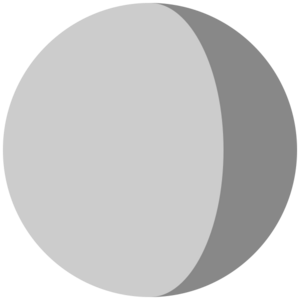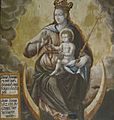Crescent facts for kids

A crescent is a special shape you often see in art and symbols. It looks like the Moon when it's just a sliver in the sky. Imagine a round disk, like a full moon. Now, imagine a smaller circle cutting a bite out of that disk. What's left is the crescent shape. It has two curved edges that meet at two points, like the tips of a banana or a new moon.
Contents
What is a Crescent?
The word "crescent" comes from a Latin word meaning "growing." This makes sense because the Moon appears as a crescent when it is "growing" from a new moon to a full moon. This shape is very old and has been used in many cultures and religions for thousands of years.
Crescents in Art and History
The crescent shape is very important in art and history. It often represents the Moon, night, or goddesses connected to the Moon.
Symbols and Meanings
- Moon and Stars: The crescent is often seen with a star, especially in symbols related to the night sky.
- Goddesses: In ancient times, goddesses like Artemis (Greek) and Selene (Roman) were often shown with crescents. They were linked to the Moon.
- Flags and Emblems: Many countries and groups use the crescent in their flags or symbols. It is a well-known symbol for the Ottoman Empire and is used by the International Red Cross and Red Crescent Movement.
- Heraldry: In heraldry, which is the study of coats of arms, the crescent is a common design. It can mean different things, like a second son in a family.
Images for kids
-
Miniature of Madonna on the crescent (Rohan Master, Hours of René of Anjou, 15th century)
-
Bust of Selene on a Roman sarcophagus (3rd century)
-
Taq-e Bostan, from the Sassanid Empire of Persia (pre-Islamic era). Note the crescent above the arch.
-
Triple crescent badge of Henry II of France (Château d'Écouen)
-
Mamluk lancers, early 16th century (etching by Daniel Hopfer)
-
The painting of the 1571 Battle of Lepanto by Tommaso Dolabella (c. 1632) shows a variety of naval flags with crescents attributed to the Ottoman Empire.
-
A naval battle painting of the Barbary state of Ottoman Algiers titled A Sea Fight with Barbary Corsairs by Laureys a Castro, c. 1681
-
Madonna on the crescent, Bad Waldsee church (17th century)
-
Portrait of a Lady as Diana by Pompeo Batoni (1760s)
-
Three examples of coats of arms with crescents from the Dering Roll (c. 1270): No. 118: Willem FitzLel (sable crusily and three crescents argent); no. 120: John Peche (gules, a crescent or, on a chief argent two mullets gules); no. 128: Rauf de Stopeham (argent, two (of three) crescents and a canton gules).
-
Coat of arms of the Neuamt bailiwick of Zürich (16th century). Its reversed crescent was taken up in the 20th-century municipal coats of arms of Niederglatt, Neerach and Stadel (canton of Zürich).
-
The emblem of the International Red Cross and Red Crescent Movement around the world
See also
 In Spanish: Media luna (símbolo) para niños
In Spanish: Media luna (símbolo) para niños
















